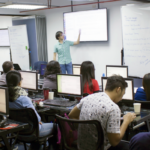Course Overview
React JS is a powerful front-end JavaScript framework, but with great power comes great responsibility! Unlike Angular JS, React JS is not particularly prescriptive in terms of how applications should be structured.
This course presents a battle-tested, practical approach to building front end applications with React JS that are extensible, maintainable, and readily testable.
Through progressive elaboration of worked code examples, course participants will create a full front-end application using React JS, integrated with a fully functioning REST API. Note: a runnable server-side API application is provided as part of course materials; development of such an API is not in scope for this particular course.
The course begins with a one-day prelude, covering key concepts in core JavaScript; participants do not need to have prior experience coding in JavaScript (although the ability to code in some other language is still necessary).
Adopting a Component-based UI approach, we next demonstrate how to structure user interface elements according to the Atomic Design System. Participants will learn how to iterate UI designs within a cross-functional team using Storybook, for ease of visual testing (ie. designer/developer workflow). Further, we teach how to use SaSS to generate parameterized, namespaced CSS stylesheets, matching the Atomic Design components described in the project’s Storybook assets.
Ultimately, these techniques are combined in detailed, practical lessons in correct usage of React JS and Redux to produce a working front-end application, integrated with a typical REST API.
Learning Outcomes
- Create a full front-end application using React JS, integrated with a fully functioning REST API
Course Outline
Core JavaScript
- Introduction
- Variables and Data Types
- Operators
- Functions
- Conditional Statements
- Loop Statements
- Data Structures
- Arrays
- Object and Inheritance
HTML DOM
- DOM Document
- DOM Selectors
- DOM Events and Handlers
- DOM Manipulation
Component-based UI Development
- Introduction to Design Systems
- Atomic Design concepts
- Implementing Atomic Design using Storybook
- Structuring SaSS for React UIs with Atomic Design namespacing
React
- Components
- JSX
- States
- Props validation
- Lifecycle
- Forms
- Routers
- Flux Concepts
Redux
- Overview
- Core concepts
- Data Flow
- Store
- Actions
- Pure Functions
- Reducers
- Middleware
Skill Level
Suitable For
Experienced developers who want to learn how to build readily testable front-end applications with React JS
Prerequisites
- WEB-101 — Web Development Fundamentals (or equivalent experience/training).
Duration
day
Related Topics
Skill Level
Suitable For
Experienced developers who want to learn how to build readily testable front-end applications with React JS
Duration
day
Related Topics
Course Overview
React JS is a powerful front-end JavaScript framework, but with great power comes great responsibility! Unlike Angular JS, React JS is not particularly prescriptive in terms of how applications should be structured.
This course presents a battle-tested, practical approach to building front end applications with React JS that are extensible, maintainable, and readily testable.
Through progressive elaboration of worked code examples, course participants will create a full front-end application using React JS, integrated with a fully functioning REST API. Note: a runnable server-side API application is provided as part of course materials; development of such an API is not in scope for this particular course.
The course begins with a one-day prelude, covering key concepts in core JavaScript; participants do not need to have prior experience coding in JavaScript (although the ability to code in some other language is still necessary).
Adopting a Component-based UI approach, we next demonstrate how to structure user interface elements according to the Atomic Design System. Participants will learn how to iterate UI designs within a cross-functional team using Storybook, for ease of visual testing (ie. designer/developer workflow). Further, we teach how to use SaSS to generate parameterized, namespaced CSS stylesheets, matching the Atomic Design components described in the project’s Storybook assets.
Ultimately, these techniques are combined in detailed, practical lessons in correct usage of React JS and Redux to produce a working front-end application, integrated with a typical REST API.
Learning Outcomes
- Create a full front-end application using React JS, integrated with a fully functioning REST API
Course Outline
Core JavaScript
- Introduction
- Variables and Data Types
- Operators
- Functions
- Conditional Statements
- Loop Statements
- Data Structures
- Arrays
- Object and Inheritance
HTML DOM
- DOM Document
- DOM Selectors
- DOM Events and Handlers
- DOM Manipulation
Component-based UI Development
- Introduction to Design Systems
- Atomic Design concepts
- Implementing Atomic Design using Storybook
- Structuring SaSS for React UIs with Atomic Design namespacing
React
- Components
- JSX
- States
- Props validation
- Lifecycle
- Forms
- Routers
- Flux Concepts
Redux
- Overview
- Core concepts
- Data Flow
- Store
- Actions
- Pure Functions
- Reducers
- Middleware



